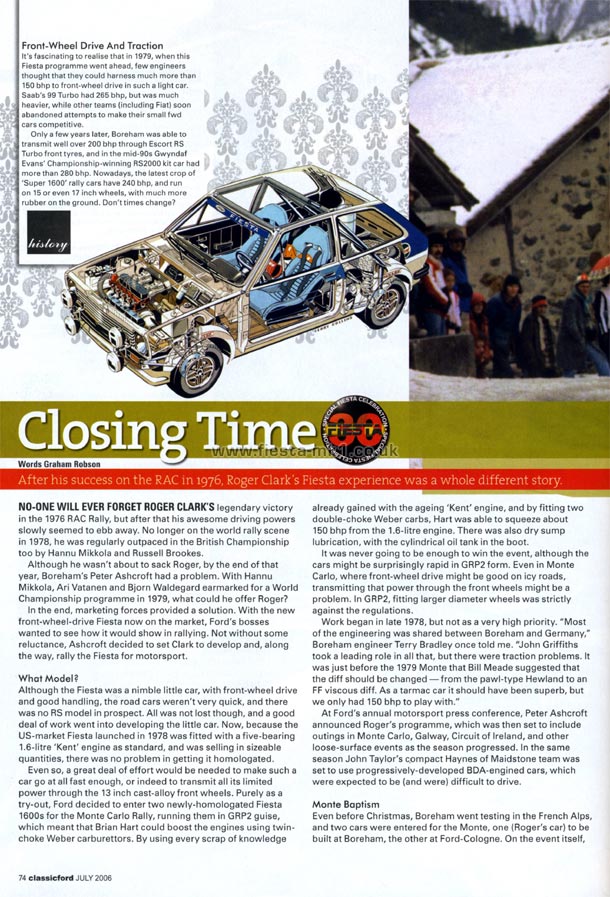Copy of Article Text Below
Closing Time - Clark's Fiesta - After his success on the RAC in 1976, Roger Clark's Fiesta experience was a whole different story.
Words Graham Robson
Front-Wheel Drive And Traction
It's fascinating to realise that in 1979, when this Fiesta programme went ahead, few engineers thought that they could harness much more than 150 bhp to front-wheel drive in such a light car. Saab's 99 Turbo had 265 bhp, but was much heavier, while other teams (including Fiat) soon abandoned attempts to make their small fwd cars competitive.
Only a few years later, Boreham was able to transmit well over 200 bhp through Escort RS Turbo front tyres, and in the mid-90s Gwyndaf Evans' Championship-winning RS2000 kit car had more than 280 bhp. Nowadays, the latest crop of 'Super 1600' rally cars have 240 bhp, and run on 15 or even 17 inch wheels, with much more rubber on the ground. Don't times change?
No-one will ever forget Roger Clark's legendary victory in the 1976 RAC Rally, but after that his awesome driving powers slowly seemed to ebb away. No longer on the world rally scene in 1978, he was regularly outpaced in the British Championship too by Hannu Mikkola and Russell Brookes.
Although he wasn't about to sack Roger, by the end of that year, Boreham's Peter Ashcroft had a problem. With Hannu Mikkola, Ari Vatanen and Bjorn Waldegard earmarked for a World Championship programme in 1979, what could he offer Roger?
In the end, marketing forces provided a solution. With the new front-wheel-drive Fiesta now on the market, Ford's bosses wanted to see how it would show in rallying. Not without some reluctance, Ashcroft decided to set Clark to develop and, along the way, rally the Fiesta for motorsport.
What Model?
Although the Fiesta was a nimble little car, with front-wheel drive and good handling, the road cars weren't very quick, and there was no RS model in prospect. All was not lost though, and a good deal of work went into developing the little car. Now, because the US-market Fiesta launched in 1978 was fitted with a five-bearing 1.6-litre 'Kent' engine as standard, and was selling in sizeable quantities, there was no problem in getting it homologated.
Even so, a great deal of effort would be needed to make such a car go at all fast enough, or indeed to transmit all its limited power through the 13 inch cast-alloy front wheels. Purely as a try-out. Ford decided to enter two newly-homologated Fiesta 1600s for the Monte Carlo Rally, running them in GRP2 guise, which meant that Brian Hart could boost the engines using twin-choke Weber carburettors. By using every scrap of knowledge already gained with the ageing 'Kent' engine, and by fitting two double-choke Weber carbs, Hart was able to squeeze about 150 bhpfrom the 1.6-litre engine. There was also dry sump lubrication, with the cylindrical oil tank in the boot.
It was never going to be enough to win the event, although the cars might be surprisingly rapid in GRP2 form. Even in Monte Carlo, where front-wheel drive might be good on icy roads, transmitting that power through the front wheels might be a problem. In GRP2, fitting larger diameter wheels was strictly against the regulations.
Work began in late 1978, but not as a very high priority. "Most of the engineering was shared between Boreham and Germany," Boreham engineer Terry Bradley once told me. "John Griffiths took a leading role in all that, but there were traction problems. It was just before the 1979 Monte that Bill Meade suggested that the diff should be changed - from the pawl-type Hewland to an FF viscous diff. As a tarmac car it should have been superb, but we only had 150 bhp to play with."
At Ford's annual motorsport press conference, Peter Ashcroft announced Roger's programme, which was then set to include outings in Monte Carlo, Galway, Circuit of Ireland, and other loose-surface events as the season progressed. In the same season John Taylor's compact Haynes of Maidstone team was set to use progressively-developed BDA-engined cars, which were expected to be (and were) difficult to drive.
Monte Baptism
Even before Christmas, Boreham went testing in the French Alps, and two cars were entered for the Monte, one (Roger's car) to be built at Boreham, the other at Ford-Cologne. On the event itself,.....
|





